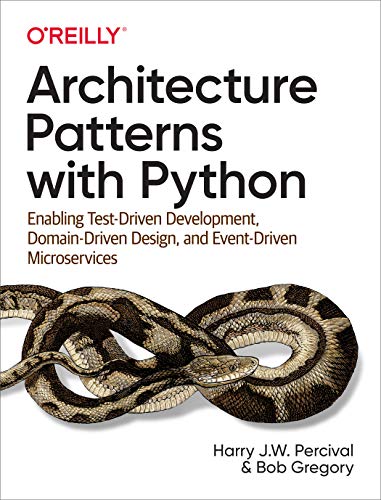Overview of Architecture Patterns with Python: Enabling Test-Driven Development, Domain-Driven Design, and Event-Driven Microservices Link to heading
Summary Link to heading
Architecture Patterns with Python: Enabling Test-Driven Development, Domain-Driven Design, and Event-Driven Microservices is a technical guide by Bob Gregory and Harry Percival that explores the intersection of several advanced software development practices within the Python programming environment. The book primarily focuses on demonstrating how patterns from Domain-Driven Design (DDD), Test-Driven Development (TDD), and Event-Driven Architecture can be leveraged to build robust and scalable systems. It provides an in-depth look at structuring Python applications using these methodologies to ensure maintainability and scalability. The narrative uses practical, real-world examples to illustrate how these principles can be applied effectively in the development lifecycle.
Review Link to heading
The book has been well-received for its clear and structured approach to describing complex architectural patterns. One of its key strengths is combining theoretical insight with practical coding examples, which facilitates better understanding and application of the concepts. Gregory and Percival successfully blend three major methodologies - TDD, DDD, and Event-Driven Microservices - into a cohesive guide, which is both comprehensive and accessible, even for those who may not be familiar with all the topics initially. A notable critique is that it may be dense for absolute beginners, given the complexity of concepts like Domain-Driven Design and Event-Driven Microservices. Nonetheless, the authors counter this with thorough explanations and a progressive build-up of ideas.
Key Takeaways Link to heading
- Integration of Patterns: The book skillfully combines Domain-Driven Design, Test-Driven Development, and Event-Driven Architecture, demonstrating how they complement each other in developing sustainable Python applications.
- Importance of Testing: It emphasizes a rigorous test-driven approach, showcasing how tests can guide the design and help manage complexity in code and architecture.
- Domain-Focused Design: Readers learn about the benefits of aligning code architecture with domain-specific language and concepts, enhancing clarity and reducing communication gaps.
- Event-Driven Benefits: The book explores how event-driven approaches can help decouple components, improve scalability, and enable better fault-tolerance in applications.
- Practical Application: Through practical examples, the authors provide insights into moving from theory to practice, using Python to implement principles effectively.
Recommendation Link to heading
This book is highly recommended for Python developers looking to advance their understanding of software architecture patterns. It is particularly beneficial for those who are familiar with Python and are interested in expanding their knowledge of modern design concepts like DDD, TDD, and Event-Driven Architecture. Software architects and engineers seeking to enhance their skills in building scalable and maintainable systems will find the insights and strategies presented of great value. However, those new to these concepts may need supplementary resources to fully grasp some of the more complex ideas discussed.
